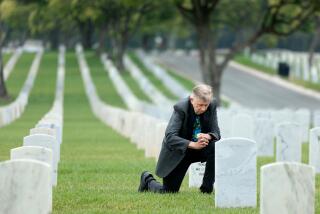U.S. Must Look to Its Own Rights Abuses
- Share via
When Mikhail S. Gorbachev was confronted with the circumstances of Andrei Sakharov as an example of blatant human-rights abuses in his country, he countered with the name of Leonard Peltier. The mention of an obscure Native American political prisoner is just “a feeble attempt to get back at us,” the U.S. State Department charged.
“Obscure” though he may be to the State Department, Peltier is a household name to the 1.5 million Native Americans in this country, and to many people of conscience throughout the world--even though most Americans have never heard of him.
Peltier has been in the federal penitentiary at Leavenworth for 10 years. During that time he has become a powerful symbol of the United States’ persecution of Native Americans fighting for religious freedom and against the continuing expropriation of their lands by major corporations in league with tribal governments backed by the Bureau of Indian Affairs. Indians were forceably moved to these reservations because the barren lands were thought to be worthless. Now even these areas are coveted--by energy corporations--because they have been found to be rich in oil, uranium and coal.
Now a delegation of Peltier’s legal staff and Indian activists has gone to Moscow to further educate the Soviets about Peltier and to plead for international attention. The importance of the case has been consistently ignored amid all the diplomatic maneuvering. But the very real issues of genocide, government oppression and suppression of religion that the Soviets have raised need to be heard internationally.
Connection to hereditary land is a vital and intrinsic part of traditional Native American religion. The Indian way of life involves closeness and harmony with the land. Yet the continuing hunger of the non-Indian colonizers of this country for that sacred land has resulted in a policy of suppressing traditional religions as part of the process of confiscating Indian lands.
In the not-so-distant past, traditional Indians were forbidden by law from taking part in most major Indian ceremonies. As recently as 10 years ago the very sacred Sun Dance ceremony was still outlawed on the Pine Ridge Reservation in South Dakota. This suppression of religion became institutionalized with the Dawes Allotment Act of 1887. In the schools, which nearly all Indian children were forced to attend, only Christianity was taught. The children were forbidden to learn or to practice their own religion, and often were punished physically even for speaking their own language.
Peltier was on the Pine Ridge Reservation in South Dakota, not far from Wounded Knee, helping to maintain a small spiritual community of traditional Indians, who feared retaliation from tribal chairman Richard Wilson for their resistance to his attempts to sell sacred land. Two federal agents in unmarked cars drove directly into the living compound of the community, causing a gunfight that resulted in the deaths of the two agents and one Indian man. The death of the Indian man was never investigated.
Despite an abundance of other suspects, the government chose to vigorously prosecute Peltier, who was a leader of the community and a strong advocate for the rights of his people.
According to court documents and other records, his arrest, extradition and trial have highlighted consistent and extreme examples of government misconduct. He was extradited on the basis of an affidavit coerced from an Indian woman; the government later admitted that it was entirely false. Peltier then was convicted largely on testimony given by three young Indians who had been threatened and physically abused by government agents. His trial was in violation of his due-process rights, and was marked by intimidation of witnesses and distortion and suppression of evidence.
Peltier has an appeal pending before the Eighth Circuit Court in St. Louis. The move for a new trial is supported by Amnesty International, 55 members of Congress, the National Assn. of Criminal Defense Lawyers and 74 individuals and organizations in the international religious community. These include Bishop Desmond M. Tutu of Johannesburg, the Rev. Jesse Jackson, Archbishop Edward W. Scott of Canada, the Very Rev. James Parks Morton of the Cathedral of St. John the Divine in New York, eight Episcopal bishops and Rabbi Balfour Brickner of New York.
American Indians are the most oppressed religious group in this country. And the Soviets have the right to reproach the U.S. government for their treatment. Yet, while the validity of the Soviets’ accusation is undeniable, it is by no means a reason to ignore the very real oppression that exists in the Soviet Union. The false imprisonment of Andrei Sakharov can no more be tolerated than the false imprisonment of Leonard Peltier.
Still, as long as our treatment of Native Americans continues to shame us, we lack the moral strength to speak effectively to the world about Soviet abuses. To be a credible advocate of human rights, we must recognize and remedy the abuses that occur in our own backyard.
More to Read
Sign up for Essential California
The most important California stories and recommendations in your inbox every morning.
You may occasionally receive promotional content from the Los Angeles Times.










